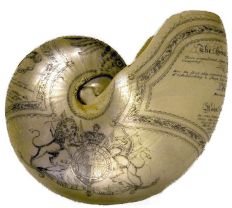

Above, the 3D-printed skeleton mounted internally and painted (grey indicates missing or shattered bones).
In 2019 the graves of 50 adults and children from the Roman period were discovered and excavated when a new school was being built in Somerton, Somerset. See: https://www.bbc.co.uk/news/uk-england-somerset-51018178
The skeleton of a dog was found at the same time. The dog skeleton was to be put on display but as some of the bones were fragmentary and all were delicate, and also because research would need to be undertaken on the skeleton, it was decided to 3D scan the bones (some of which are only a few millimetres long) and then 3D print replicas of them so that the replica bones could be mounted as a largely complete skeleton. Some of the fragile bones required conservation work and repair before they could be scanned (see image below). All simple breaks were adhered with Paraloid B72 adhesive, after consolidating broken edges with Paraloid B72 consolidant at 10% in acetone. The adhesive and consolidant are both reversible with the application of acetone. Complex breaks and gap-filling were addressed with Gampi Japanese tissue paper with neutral pH PVA (see: Larkin, N. R. 2016. Japanese tissue paper and its use in osteological conservation. Journal of Natural Science Collections, Vol 3: 62-67).
Two mounted dog skeletons were used for reference, at the Cole Museum of Zoology in the School of Biological Sciences, University of reading.

Above: the bones of one forelimb. Note that the humerus and ulna are both in three pieces and the radius in two pieces. These had to be repaired before 3D scanning took place.
All of the bones were 3D scanned by Steven Dey of ThinkSee3D Ltd using photogrammetry scanning for the larger bones and structured light scanning for the smaller bones including all the vertebrae, neck, tail and paw bones. The resulting 3D digital models were used to 3D print replicas of individual bones of the (mostly complete) dog skeleton and the extra skull. These were 3D printed in gypsum, the material that is known to be one of the most stable 3D printing materials. It also provides a matt texture that takes paint well. He also scanned, digitally scaled (using the preserved mandible pieces as a scaling guide) and 3D printed the skull of a similar breed of dog provided by Somerset Heritage Centre. The tip of the lower jaw of this separate dog was also scanned and digitally blended onto the scan of the roman dog mandible to fill in the missing portion (in the photos above this tip of the lower jaw happens to be the same shade of grey as the background, so it is difficult to see - making the dog appear a bit goofy!). The digital models of the preserved portions of the Roman dog pelvis were similarly blended onto an existing model of a dog pelvis found online. In both cases only the areas that were preserved of the Roman dog were painted (with artists acrylic paints) to match the bones, but the digitally reconstructed areas were painted a neutral grey, to indicate that they had not been preserved. The detailed digital 3D models of all the bones have been passed on to the owners of the skeleton for archiving and possible future research.
These replica 3D bones were mounted onto an armature made from steel and brass rods bent to the right shape and welded or silver-soldered into place. Steel rods were used to indicate the ribs that were too badly shattered to replicate. The temporary plinth for the skeleton is made from MDF treated with two coats of Dacrylate varnish (to reduce off-gassing of VOCs) and painted.
The skeleton is now on display at The NEWT In Somerset.

